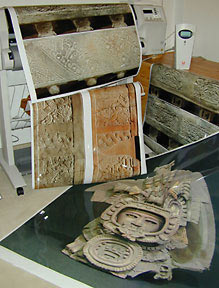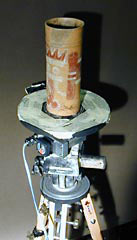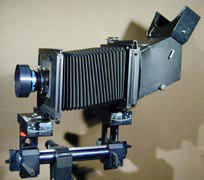FLAAR evaluates the potential of Hewlett-Packard wide format color inkjet printers for their potential to create entire museum exhibits of large format enlargements of ancient art. At a photography trade show the FLAAR director had the opportunity to hear a presentation by the key person at the wide format division of Hewlett-Packard. This presentation made us realize that the HP DesignJet was good enough to produce exhibit-quality prints.
 Thus it was not before long that an actual HP 2800 CP printer walked in the door of our office in Germany. We have been using this printer ever since. The quality is sure better than the mere 300 dpi of our previous Encad printer. Actually in this view inside our office you see several prints. All are from the HP printer except one; that one is from a printer that costs more than twice the cost of the HP? Is that other print really worth $30,000? Since the HP printer costs about $10,000 to $14,000 (depending on accessories), and as the quality of the HP output is impressive as is, why spent twice as much?
Thus it was not before long that an actual HP 2800 CP printer walked in the door of our office in Germany. We have been using this printer ever since. The quality is sure better than the mere 300 dpi of our previous Encad printer. Actually in this view inside our office you see several prints. All are from the HP printer except one; that one is from a printer that costs more than twice the cost of the HP? Is that other print really worth $30,000? Since the HP printer costs about $10,000 to $14,000 (depending on accessories), and as the quality of the HP output is impressive as is, why spent twice as much?
The print on the floor is of a Tiquisate incensario (the same incensario as on the cover of Nicholas Hellmuth's 1975 report which first announced the recognition of the Teo-Tiquisate culture). The print on the table to the right and high up on top of the printer are cylindrical tripods.
The two orange rollouts (vertical) are from Late Classic Tiquisate vases. These are several centuries after the end of Teotihuacan influence. The iconography of these late Tiquisate pots is not well documented in the traditional publications on Mesoamerican ceramics. Thus FLAAR Photo Archive is working at finding and photographing as many late Tiquisate vases as possible.
The program of direct-digital rollouts of pre-Columbian vases continues in full swing. The FLAAR Photo Archive crew, combined with the expertise of the Digital Imaging Technology Center, have dedicated themselves to recording authentic pre-Columbian ceramic art. Nowadays so many of the polychrome Maya vases are clever forgeries or worse, were once authentic but have been repainted under the clever guise of "restoration." It has gotten so bad that two expert epigraphers each rendered scholarly decipherment, in major publications, of a hieroglyph dreamed up by capable painter Lee Moore in Miami. I have snapshots of the vase in its original condition, and the infamous section of the text was on a section of the pot that was missing. The "restorer" made a new piece and made up a hieroglyph for that new section of the text.
Since the FLAAR Photo Archive began three decades ago recording Teotihuacan influence on the art of Guatemala it is only fitting that we continue coverage of the ceramic art of Tiquisate as we enter the new millennium. Thus in the last weeks we have been photographing a wide range of Tiquisate art, from the traditional Early Classic Tiquisate cylindrical tripods to Late Classic and terminal Classic ceramic art from the wider area of Escuintla, Guatemala.
 Here is a sample of a major late vase, most likely from the greater Escuintla style area. The Museo Popol Vuh, Universidad Francisco Marroquin, has several vases of this style. Another dozen are in private collections.
Here is a sample of a major late vase, most likely from the greater Escuintla style area. The Museo Popol Vuh, Universidad Francisco Marroquin, has several vases of this style. Another dozen are in private collections.
The vase is on the rotating turntable, all computer controlled. Since these are direct-digital rollouts they are dimensionally accurate. Their accuracy is a result of the ability to measure the height and circumference directly as the vase is rotated. It is easy to detect when the rollout rotational speed is too fast or too slow (hence distorting the rollout by elongating the image or scrunching the image). Every vase done with the FLAAR rollout system is measured as it rotates. The measurement is fed into the computer and the rotational factor is calculated so that a square is actually square, not rectangular as on rollouts based on trial-and-error.
Although the direct-digital technology is far more advanced than old-fashioned film-based rollouts, we have recently upgraded the FLAAR rollout system even more, with the best 4x5 camera available from Europe, the Swiss-made Sinar X, from Sinar-Bron.
 This handsome vase, done in the dark red so typical of Late Classic ceramics of Escuintla, pictures a late form of the goggle-eyed deity Tlaloc. At this time in the Late Classic the Tlaloc is no longer in the Teotihuacan form, but has evolved into a local provincial version.
This handsome vase, done in the dark red so typical of Late Classic ceramics of Escuintla, pictures a late form of the goggle-eyed deity Tlaloc. At this time in the Late Classic the Tlaloc is no longer in the Teotihuacan form, but has evolved into a local provincial version.
This camera makes it possible to align the film plane more precisely with the profile of the pot (since not all pots are cylindrical in shape). As a result the rollouts being produced this season are even sharper than those produced earlier. The better the plane of focus and depth of field, the easier it is to enlarge the rollouts. We already set a record by enlarging a rollout to 14 feet in length (from our 70mm film-based Seitz rollout system). We installed an Encad wide format color printer at the Museo Popol Vuh so we can do digital prints directly from the digital rollout camera, all in-situ.































